Rohit Sharma’s ODI career had two separate halves, both quite contrasting.
One from his debut in ODI cricket against Ireland in 2007 to the start of 2013, during this phase of his career, he batted everywhere, from the opening to the no. 7 position. That was a horrible phase in his career.
1978 runs in 81 innings with an average of 30.43 and a strike rate of 77.93. 16 50+ scores, including 2 hundred, A 50+ score in every 5th inning.
These numbers are too far from being called even average; they are ridiculously bad, especially for a batsman of his calibre.
Even though Rohit opened for 3 matches against South Africa during this time, he scored 23, 1, and 5.
Then came 23 January 2013. In the 4th ODI Match against England, He was given a chance to open again after a gap of 2 years.
Sharma then scored 83 off 89 balls. That inning was a breakthrough moment in his ODI career; since the end of this match, he came to bat in the 1st over of Indian Innings (whenever he plays) for each and every ODI match, except a single game against Afghanistan in 2014, where he came to bat at no.3.
The numbers totally changed in this phase, 7305 runs, almost 3.5 times as compared to the previous in the innings (141) which are just 1.75 times as the previous. The average is now 57.97, with the strike rate being 92.59.
59 50+ scores with 27 centuries, meaning the no. of innings taken to score a 50+ score in ODI cricket (2.4) has now become comparatively half for Hitman.
Everything has gone upward for him. He is now one of The Best ODI Openers of All Time from being close to average.
But how to compare his numbers with the openers from different generations, a raw comparison, will be entirely inappropriate. ODI cricket has changed throughout the years, and due to that, the inflation in runs has increased throughout the years. An average of 47 with a Strike Rate of 87 is just decent enough in the current period; in the 80s, these numbers were sufficient for Viv Richards to be called The Greatest ODI Batsman of all time.
I have selected all the openers with more than 5000 runs in One-Day Cricket (As an opener).
The Table is given below
As visible in the table, Sachin Tops the Runs Chart, Rohit has the highest Average, and no one scores as fast as Sehwag.
But should we compare these numbers directly? The answer to this will be No.
As discussed in our Previous Articles, ODI cricket has changed significantly since its inception.
For example, During Desmond Haynes’s career (1978-1994), an average of 218 runs was scored per 50 overs. Now, if you compare it with someone like Quinton De Kock’s Career (2013-2022), 265 runs are scored in the same amount of overs.
In my previous article on Era Adjusted Bowling Average, Economy and Strike Rate in ODI Cricket, I explained the Z-Factor concept and how we can use it to derive era-adjusted numbers, which can be further used to compare the 2 players of Different Generation.
Just like we did for ODI Bowlers, We will do it for all the 24 openers who fulfilled our essential criteria.
Z-Factor Values for ODI Openers with over 5000 runs
Still, For a shorter Introduction, the Z-Factor is the ratio of a player metric (average, strike rate, etc.) to the average value of that metric during the player’s playing days.
For Example, The Z-Factor of Batting Average for Rohit Sharma will be equal to Rohit’s Batting Average/ Mean Batting Average during Rohit’s Playing years.
Now, We will do this on 2 scales, one in which we consider the mean averages of the Top 6 batsmen and another in which we will just consider the mean average of only opening batsmen in that period. The average of these two values will be taken as a final value.
Let’s take the example of Saeed Anwar; he has an average of 39.98 as an opener in ODI cricket, and the mean average of the Top 6 Batsman during his career was 31.95.
That means the Z-Factor value associated with his batting average will be 39.98/31.95=1.25. Now, the mean average of Opening Batsmen during his career was 32.71. So, the Z-Factor will be 39.98/32.71=1.22 in this case. So, to make it clear, we will take the average of both the Z-Factor values, which will be 1.24 in the case of Anwar.
Note: In Both considerations, we will take the mean numbers from the player’s career opening days, from the year they started opening in international cricket to the year in which they played their last match as an opener.
However, in the case of Rohit Sharma, we will take the average numbers from 2013, as he opened for just 3 innings between 2011 and 13.
Rohit Again Tops the Average Column, Sachin at 2nd. Regarding Strike Rate, Sehwag, Gilchrist, Jayasuriya, Tendulkar, and Warner are in the Top 5. However, no one scores a 50+ score at a better rate than Rohit Sharma; in terms of scoring a century, Master Blaster is significantly better than anyone else.
Sachin is the only batsman to be present in the Top 4 in all the criteria we have used, top one, second in 2, and 4th in one. This is absolutely phenomenal level stuff, especially for a person who has played 340 innings as an ODI opener. There is no doubt about him being the Greatest ODI Opener of All Time.
Tharanga and Iqbal are right at the bottom of the chart; Tharanga has the lowest value for both average and strike rate, and Iqbal has the 2nd lowest for both.
Accommodated/Standard Form:
As we explained the concept of the Z-Factor earlier, we will now use these Z-Factor values to obtain the numbers into standard/more straightforward form, taking a fixed period for every player, in our case, Rohit Sharma’s career span as an opener (2013-2022).
Mean Data for 2013-2022 (average of top 6 batsman values and openers values as stated)
- Batting Average: 35.33
- Strike Rate: 84.03
- Innings/50+ score: 4.09
- Innings/100: 15.49
Taking this as a standard, the table of adjusted numbers is given below:
Adjusted Runs are calculated considering the ratio of Average and RPI for batsmen.
Note: They are just the overall numbers in the adjusted form, off-course they tell us the brief story, but that’s not all.
Even when two players have played in the same period, One can improve his numbers by playing against weaker opposition or bowling attacks compared to another.
World Cup Stats of the Selected Openers
As the most significant cricketing event, it is significantly more important than regular bilateral matches; hence, the performance in these matches is worth a separate mention.
As the raw numbers suggest:
- 6 players average more than 55
- Only 5 batsman strikes at over 95 runs per 100 balls.
- 7 scores a 50+ score in every 2.5 innings or less
- 5 of them take 5 or fewer innings to score a century
2 batsmen are common in both aspects: David Warner and Rohit Sharma. They average over 60 (5 more than our criteria) by striking over 95 and fulfilling the other criteria.
Rohit deserved a particular appraisal by looking at the raw WC stats; he has the highest average as an opener in the ODI World Cup, and his strike rate is 5th best in the list with taking the least no. of innings to score a 50+ score (a 50+ score in every 1.89 innings) and a century( a 100 in every 2.83 innings).
Z-Factor Values for WC Stats of Selected ODI Openers
The process will be almost the same as previously stated, except for a tiny change; as in this case, we will assign weighted Z-Factors for each WC Campaign.
For Example, Shikhar Dhawan’s Z-factor for the 2015 World Cup is 1.45, and as he scored 76.72% of his WC runs in that particular World Cup, we will take “1.11” (76.72% of 1.45) as the weighted z-factor value for that World Cup for Shikhar Dhawan.
Likewise, Shikhar’s Z-Factor for WC 2019 is 1.62, and because he has played only 2 matches in this WC (due to a finger injury), he has scored only 23.28 % of his WC career runs in this particular tournament.
So the weighted Z-Factor assigned for this tournament for Shikhar will be “0.38” (23.28% of 1.62)
Combining The Weighted Z-Factors values for both of his WC campaigns will give us his final Z-Factor value for his WC career as 1.49(1.11+0.38).
That 1.49 denotes Dhawan’s average is 1.49 times better than the mean average in the WC matches he played.
Key Points from this table:
- Gary Kirsten(2.54) and Gibbs(2.25) are the only batsmen whose average is more than twice better than the mean average; Sachin and Mark Waugh followed him (both averages are 1.93 times better than the mean)
- Sehwag strikes the fastest (1.36 times better than the mean), with Gilchrist just a dot behind him (1.35 times)
- Only 4 players score 50+ score at a more than twice better rate than the mean, Tendulkar (2.4), Gibbs (2.2), Waugh(2.09) and Rohit(2.02)
- Mark Waugh’s century scoring rate is 5.77 times better than the mean; no one else has even 5 times better. The second best is Rohit Sharma, scoring a century 4.75 faster than the mean batsman.
Conclusion
That’s the end of our article, all the stats (both in raw and adjusted form) are presented, and Rohit is right among the top in both.
There is a reason why the Hitman is rated so high by the experts; in the field of overall numbers, he looks the best since Sachin, and with regards to the World Cup stats, his numbers are good enough to be considered an all-time ODI Great.
Thanks for reading to the end. Please remember to share this article on your various social media handles.

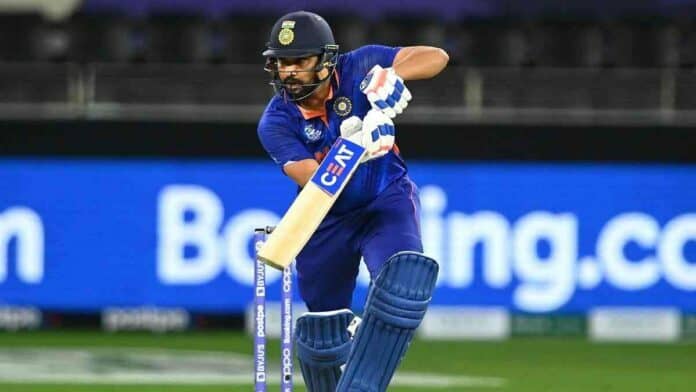
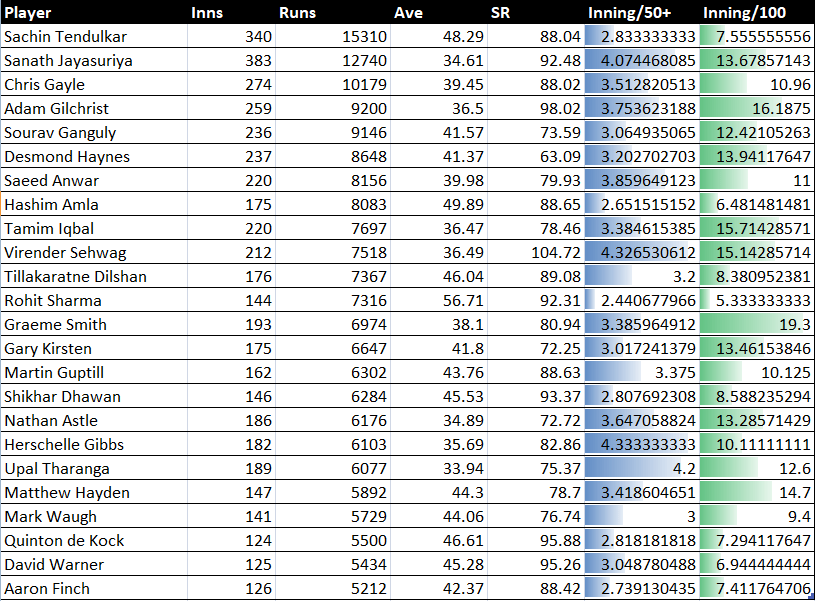
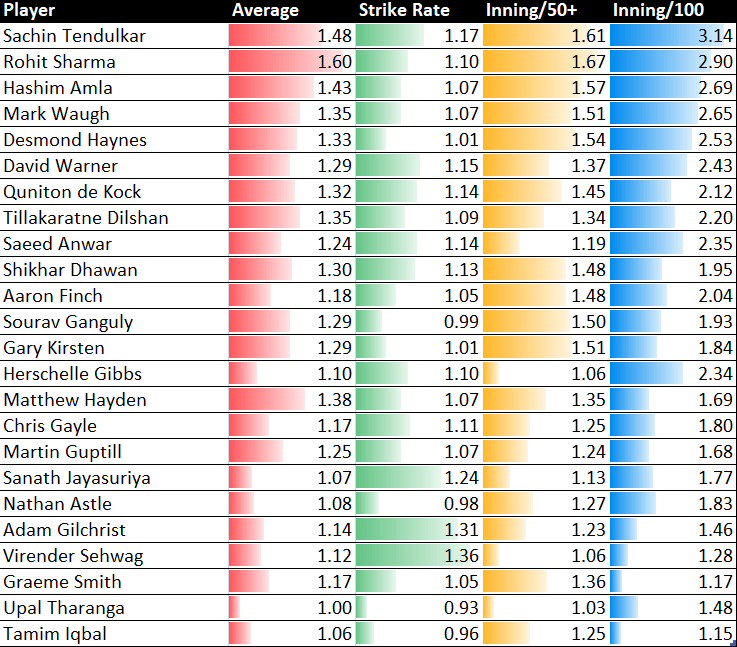
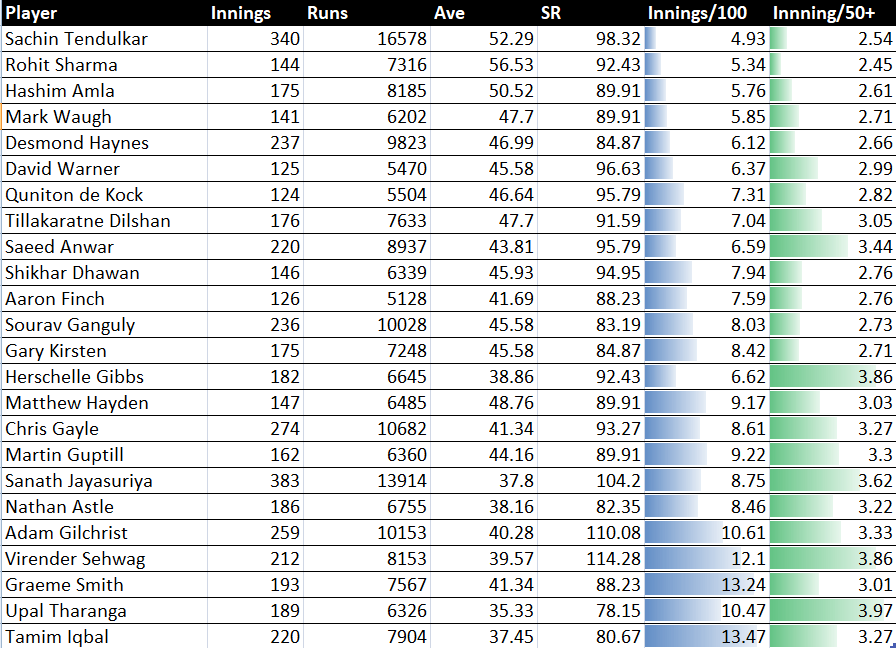
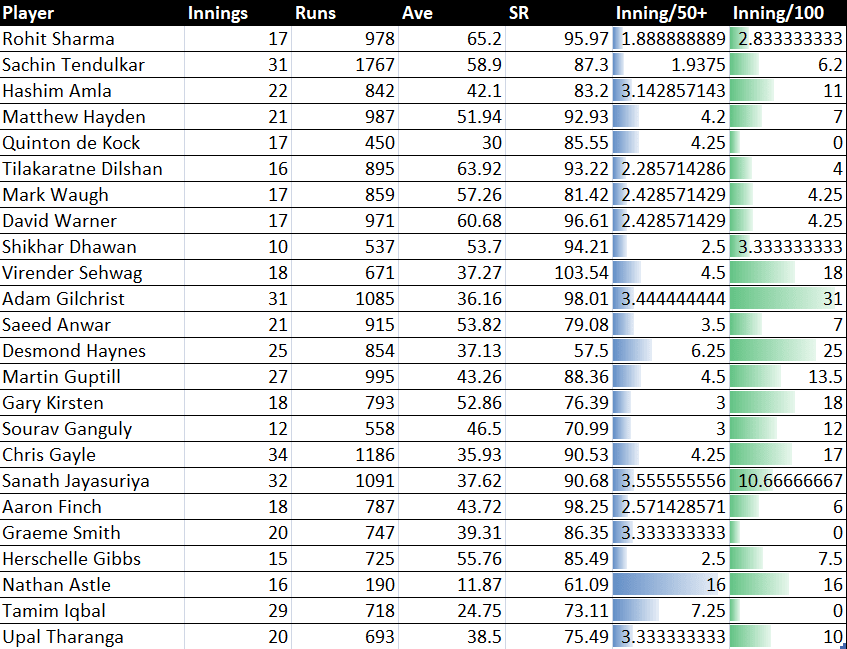
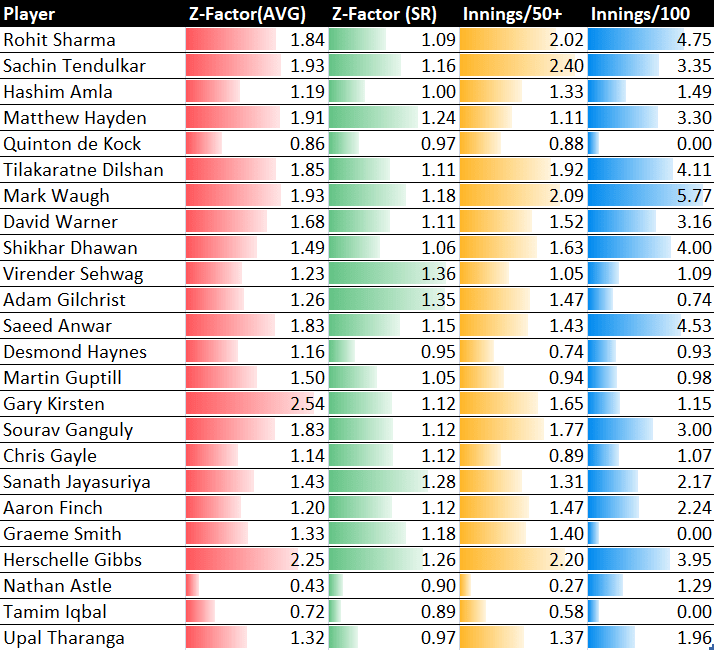
U missed out on greenidge